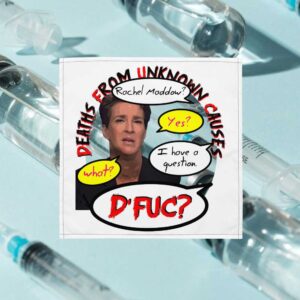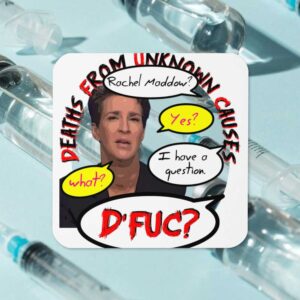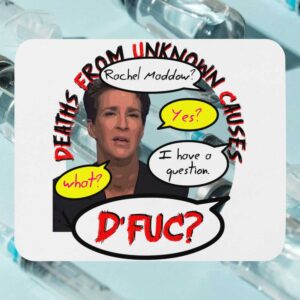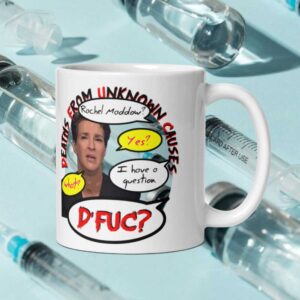Excess Deaths
- References
- Deaths: Data Notes
- Population: Centers for Disease Control and Prevention, National Center for Health Statistics
Quick Links
23,641 deaths from All Causes were among individuals of all ages
2022 vs New Normal™ for individuals of all ages in New Mexico
- 23,641 of 23,641 total deaths were from All Causes
- 100.00% of all deaths were from All Causes
- This is up 44% compared to Old Normal rates.
- 16,347 of 16,347 total deaths would have been expected under Old Normal conditions.
- 7,294 excess deaths from All Causes in 2022.
- 34,637 excess deaths from All Causes (2015-2022)
- To show this year’s deaths from All Causes are up 44% compared to Old Normal rates, we need to calculate the rates for both 2022 and for the Old Normal.
Remember, death rates are calculated to answer these questions:
- “How many individuals of all ages were there?” and
- “How many of them died from All Causes?”
The following 2 charts provide this information:
Deaths – All Causes – Both Sexes – Of All Ages | New Mexico, United-states
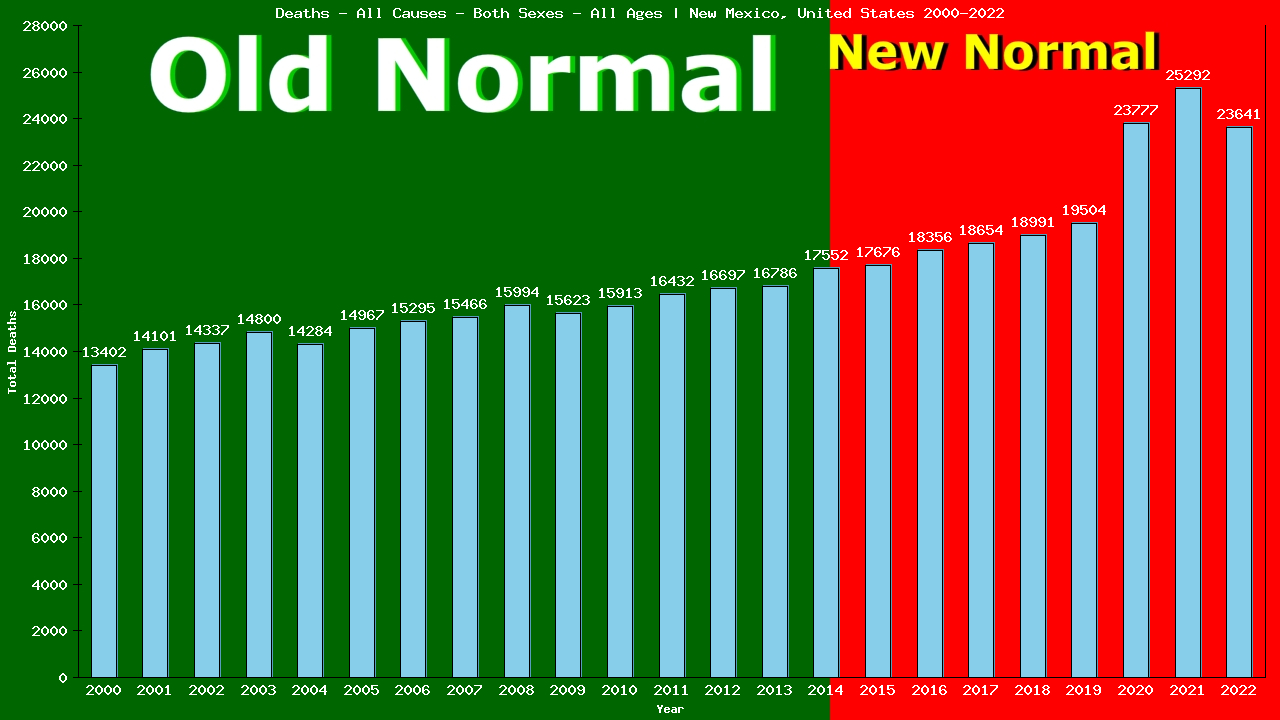
Population – Both Sexes – Of All Ages – [2000-2022] | New Mexico, United-states
![Graph showing Population - Both Sexes - Of All Ages - [2000-2022] | New Mexico, United-states](/wp-content/plugins/dfuc-display/charts/united-states/new-mexico/2022/all/Both Sexes/GrandTotal-pop.png)
From the charts, we can see that in 2022, 23,641 of 1,946,652 individuals of all ages living in New Mexico died from All Causes.
23,641 ÷ 1,946,652 = 0.01214 (2022 CDR)
The table shows there were a total of 231,649 deaths from All Causes among 27,584,776 individuals of all ages living in New Mexico in the 15 years immediately prior to the New Normal™.
231,649 ÷ 27,584,776 = 0.00840 (Old Normal CDR)
We can use the Old Normal rate to predict this year’s deaths:
2022 pop X Old Normal CDR = expected deaths
1,946,652 X 0.00840 = 16,347 expected deaths
The difference between actual and expected deaths shows lives saved or lost:
23,641 – 16,347 = 7,294
Dividing the actual deaths by the expected deaths gives us the comparative rates:
23,641 ÷ 16,347 = 1.4444
This reveals 7,294 lives lost and is 144.44% of what we expected (an increase of 44%) in deaths from All Causes among individuals of all ages living in New Mexico in 2022, as compared to the Old Normal.
This is the same method used by Public Health to calculate the 5-yr CDR (Cumulative Death Rate):
142,250 ÷ 13,683,131 = 0.01040 (5-yr CDR)
1,946,652(2022 pop) X 0.01040 = 20,237 expected deaths
The difference between actual and expected deaths:
23,641 – 20,237 = 3,404 or 3,404 lives lost
Divide actual deaths by expected deaths:
23,641 ÷ 20,237 = 1.1671 or an increase of 17%
for deaths from All Causes among individuals of all ages living in New Mexico in 2022, as compared to the previous 5 years.
Compare our Old Normal to the 5yr CDR. Does it tell the same story your TV does?
Finally, the same method can also be used to compare our Old Normal rate to the New Normal™ rate:
New Normal™ population X Old Normal rate = expected deaths
15,629,783 X 0.00840 = 131,254 expected deaths
The difference between actual and expected deaths:
165891 – 131,254 = 34,637 or 34,637 lives lost
Dividing the actual deaths by the expected deaths:
165,891 ÷ 131,254 = 1.2624 or an increase of 26%
in deaths from All Causes among individuals of all ages living in New Mexico in the New Normal™, as compared to the Old Normal.
The world has been led to believe that a deadly pandemic swept the globe beginning in 2020, causing an increase in death rates, especially among the elderly
The data show that death rates began to increase in 2015, immediately upon implementation of the UN’s 2030 Agenda for Sustainable Development, that young adults have experienced ever-increasing death rates since, and that death rates among the elderly have remained relatively stable.
Return to the top of the page to select another age category.
Deaths/100,000 both sexes GrandTotal from All Causes
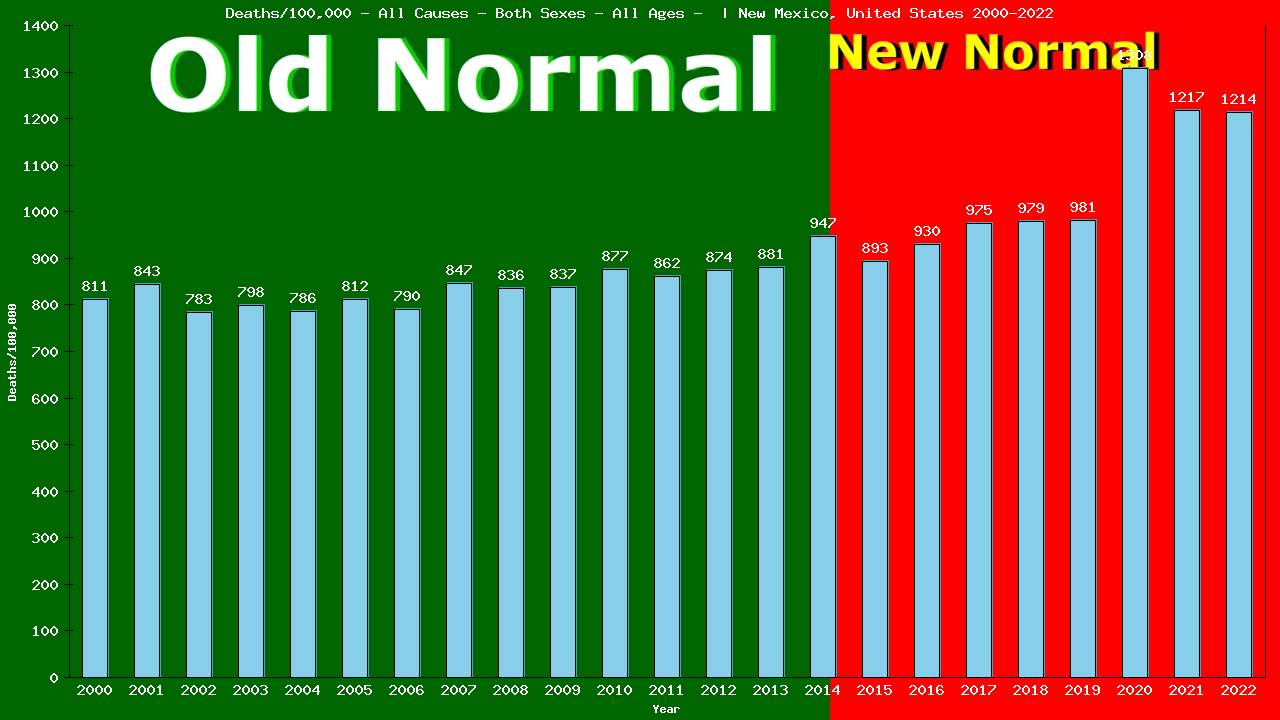
×



